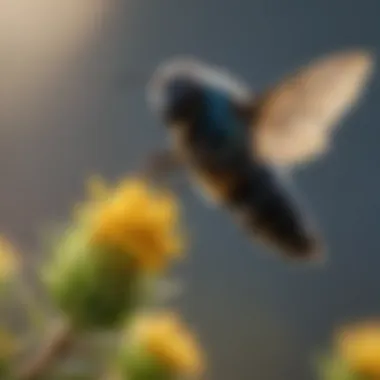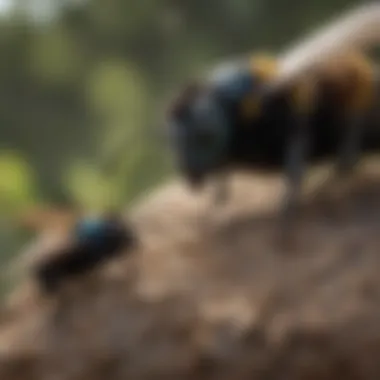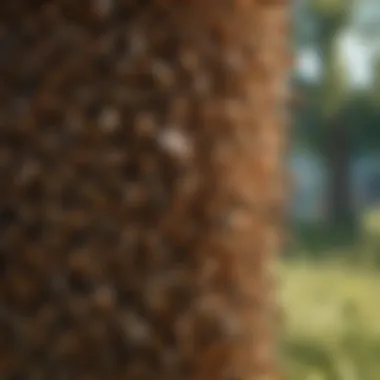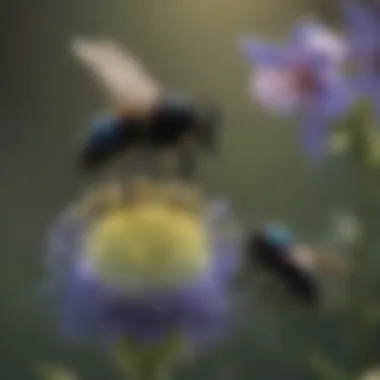Unveiling the Intricacies of Carpenter Bees and Bee Swarms: A Comprehensive Exploration


Animal Species Profile
Carpenter bees are intriguing insect species that captivate the attention of both entomologists and laypersons alike. Known for their characteristic solitary nature, carpenter bees exhibit fascinating behavior that sets them apart from their hive-dwelling relatives. These large bees boast a robust physique, with a shiny black abdomen that glistens in the sunlight. Found predominantly in woodlands and gardens, carpenter bees carve tunnels in wooden structures to make their nests, showcasing their distinctive nesting habits. Their behavior revolves around foraging for nectar and pollen, demonstrating intricate social interactions within their solitary lifestyle.
Unique Facts & Trivia
One little-known fact about carpenter bees is their unique ability to buzz pollinate, a method whereby they dislodge pollen by vibrating their flight muscles at a specific frequency. This behavior is crucial for their role in pollination, contributing to the ecosystem's well-being. Additionally, carpenter bees exhibit quirky behaviors, such as 'guarding' their nest entrances against potential threats. These bees are renowned for their resilience and adaptability, making them a vital part of the ecosystem they inhabit.
Introduction to Carpenter Bees
Carpenter bees, oftentimes misunderstood creatures, play a significant role in the ecosystem. In this article, we will delve deep into the world of these solitary bees, exploring their behavior, nesting habits, and impact on the environment. Understanding carpenter bees is essential for appreciating their importance in balancing nature's dynamics. Through a meticulous examination of their characteristics, behaviors, and interactions, we aim to offer a comprehensive guide to these intriguing creatures, shedding light on both their positive and negative aspects.
Overview of Carpenter Bees
Physical Characteristics
When it comes to physical characteristics, carpenter bees stand out for their large size and robust appearance. Their shiny black bodies mesmerize observers, while their distinct lack of dense body hair sets them apart from other bee species. This unique feature makes carpenter bees efficient pollinators, as pollen grains are less likely to stick to their bodies, allowing for better pollen transfer from flower to flower. Despite their intimidating size, carpenter bees are docile creatures, mainly focused on their solitary activities within wooden structures.
Behavior Patterns
The behavior patterns of carpenter bees revolve around their solitary nature and meticulous nesting habits. Unlike social bees that live in colonies, carpenter bees prefer solitary lives, with each female creating her nest within wooden surfaces. Their diligent drilling behavior to construct galleries for their eggs showcases their focus and determination. However, this behavior can also lead to wood damage, posing challenges for human structures in certain scenarios.
Nesting Habits


Nesting habits are central to the survival of carpenter bees and the continuity of their species. Female carpenter bees bore perfectly circular entrances into soft wood to establish their nests, where they lay their eggs and provide pollen provisions for their larvae. These nests serve as secure shelters for the developing bees, ensuring their growth and eventual emergence as adults. While this nesting behavior is essential for carpenter bee reproduction, it can inadvertently result in structural concerns for buildings and wooden fixtures.
Role in Ecosystem
Pollination Importance
The pollination importance of carpenter bees cannot be overstated, as these diligent insects play a crucial role in plant reproduction. By visiting flowers to collect pollen for their young, carpenter bees inadvertently transfer pollen between plants, enabling fertilization and seed production. Their contributions to pollination enhance biodiversity and strengthen ecosystems, making them vital components of the natural world.
Impact on Flora
Carpenter bees have a direct impact on flora health through their pollination activities. By facilitating cross-pollination, these bees aid in genetic diversity among plants, leading to stronger and more adaptive species. Additionally, their efficient pollination techniques contribute to the production of fruits, seeds, and other plant materials essential for various organisms in the ecosystem. The presence of carpenter bees ensures the vibrancy and sustainability of floral populations, illustrating their significance in ecosystem dynamics.
Carpenter Bees and Humans
Carpenter bees play a significant role in our ecosystem, especially in aiding pollination. Their physical characteristics, such as their robust body structure and distinct buzzing sound, set them apart. Furthermore, their behavior patterns, including their solitary nature and preference for certain types of wood for nesting, make them intriguing subjects. Physical Characteristics of carpenter bees often include a shiny black abdomen and a size ranging from half an inch to one inch. Behavior Patterns vary from aggressive during territorial disputes to relatively docile in other encounters. Understanding carpenter bees can help humans appreciate their role in pollinating flowers, thus enhancing the environment's biodiversity.
Wood Damage
Structural Concerns
Wood damage caused by carpenter bees can lead to significant structural concerns for wooden structures. The aspect of Structural Concerns refers to the potential weakening of wood integrity due to repeated nesting by carpenter bees. This detailed analysis offers insights into how these concerns form an integral part of the broader discussion on carpenter bees and their impact on wooden structures. Their tendency to bore into wood can compromise the structural integrity of fences, decks, and other wooden elements. This characteristic poses a perpetual challenge to homeowners and architects striving to preserve wooden structures. Structural Concerns may manifest in visible holes drilled by carpenter bees for nesting, weakening the wood over time and potentially leading to costly repairs.
Preventive Measures


Preventive measures form a crucial aspect of carpenter bee management. By implementing certain Preventive Measures, one can mitigate the risk of wood damage caused by these insects. These measures involve inspecting wooden structures regularly, filling holes with wood putty, and applying protective finishes to deter carpenter bees. The unique feature of these measures lies in their proactive approach to carpenter bee control, preventing potential infestations and structural damage. While these measures may require periodic maintenance, they serve as effective strategies in minimizing the impact of carpenter bees on wooden surfaces.
Interaction with Humans
Carpenter bees' interaction with humans can evoke both misconceptions and admiration. Common Misconceptions often revolve around mistaking carpenter bees for bumblebees or associating them with aggressive behavior. Clarifying these misconceptions is vital in fostering a harmonious relationship between humans and carpenter bees. However, beyond misconceptions, recognizing the Beneficial Aspects of these insects is essential. Carpenter bees contribute to pollination, aiding in plant reproduction and ecosystem balance. Understanding the symbiotic relationship between humans and carpenter bees can create a deeper appreciation for these creatures and promote conservation efforts.
Beneficial Aspects
The Beneficial Aspects of carpenter bees extend beyond pollination to include their role in ecosystem diversity. By helping flowers reproduce, carpenter bees play a crucial part in maintaining floral abundance and genetic variation within plant species. Their unique method of pollination, known as buzz pollination, enhances fruit and seed production in various plant species. Appreciating these beneficial aspects sheds light on the intricate ecological connections existing between carpenter bees and the surrounding plant life. Overall, recognizing the positive contributions of carpenter bees can foster a more nuanced understanding of their significance in our ecosystem.
Dynamics of Bee Swarm
In delving into the intricate realm of bee swarms, we uncover a pivotal aspect of the natural world that plays a significant role in ecological processes. Bee swarms, characterized by their collective behavior and coordinated movements, hold a crucial importance in maintaining the delicate balance of ecosystems. Understanding the dynamics of bee swarms provides insights into their social structures, communication methods, and decision-making processes, offering a compelling glimpse into the interconnectedness of these fascinating creatures. By exploring the specific elements of bee swarms, we can appreciate their adaptive strategies, resource allocation mechanisms, and response to environmental changes with a keen eye towards their survival and impact on biodiversity.
Formation of Bee Swarms
Queen Bee Role
One of the central figures in the formation of bee swarms is the queen bee, responsible for the continuity and cohesion of the colony. The queen bee's primary role revolves around reproduction, ensuring the propagation of the species and the stability of the swarm. Her unique ability to regulate the hive's population through egg-laying activities influences the social dynamics within the colony, dictating worker bee behavior and resource distribution. The queen bee's dominance and longevity within the swarm guarantee its sustainability and growth, making her a pivotal aspect of the bee swarm's functionality and organization.
Behavioral Patterns
The behavioral patterns exhibited by bee swarms offer a window into their intricate social structure and adaptive responses to external stimuli. By observing how bees interact within the swarm, communicate using pheromones, and coordinate activities such as foraging and hive maintenance, we gain valuable insights into their collective intelligence and problem-solving capabilities. These behavioral patterns not only ensure the survival of the swarm but also enhance its efficiency in resource utilization and defense mechanisms. Understanding the nuanced behaviors of bee swarms sheds light on their resilience in the face of environmental challenges and their capacity to thrive in diverse habitats.


Swarms in Nature
Migration Patterns
Migration patterns in bee swarms play a fundamental role in their survival and reproductive success, guiding them towards optimal foraging sites and suitable breeding grounds. The intricate mechanisms behind migration inform bee swarms about seasonal changes, resource availability, and potential threats, shaping their movement patterns and colony dynamics. By dissecting the migration patterns of bee swarms, we unravel a tapestry of instinctual behaviors, environmental cues, and navigational skills that enable them to traverse vast distances and adapt to varying conditions with remarkable precision.
Survival Strategies
Survival strategies adopted by bee swarms encompass a diverse range of adaptations that ensure their persistence in challenging environments. From collective decision-making processes to division of labor among colony members, these strategies enhance the swarm's ability to overcome obstacles and thrive amidst competition. By examining the unique features of survival strategies, such as swarming behavior, nest construction techniques, and predator evasion tactics, we gain a deeper appreciation for the resilience and resourcefulness of bee swarms. These strategies not only safeguard the swarm's well-being but also contribute to the broader ecological balance, showcasing the intricate interplay between bees and their natural surroundings.
Human Encounters with Bee Swarms
Safety Guidelines
Risk Mitigation:
Delving into the realm of risk mitigation within the context of encountering bee swarms sheds light on a paramount aspect of bee swarm safety. Risk mitigation strategies such as maintaining a safe distance, wearing protective gear, and identifying escape routes play a significant role in minimizing potential harm or stings. The essence of risk mitigation lies in preemptive measures, ensuring a symbiotic relationship between humans and bees by fostering a safe environment for both parties involved.
Handling Tips:
Exploring the art of handling bee swarms encapsulates a blend of caution and expertise essential for navigating these intricate ecosystems. Fundamental handling tips encompass techniques like remaining calm, avoiding sudden movements, and seeking professional assistance when necessary. The crux of handling tips lies in upholding a respectful demeanor towards bee swarms, acknowledging their importance in the ecosystem while safeguarding human well-being through informed and prudent actions.
Bee Swarm Removal
Professional Services:
Unveiling the realm of professional services in bee swarm removal underscores the specialized expertise required for managing these dynamic natural occurrences. Professional services offer a holistic approach towards bee swarm removal, encompassing assessment, containment, and relocation strategies. The distinctive feature of professional services lies in their ability to mitigate risks efficiently while ensuring the preservation of bee populations and fostering harmonious cohabitation between bees and humans.
Dos and Don'ts:
Delving into the dos and don'ts of bee swarm encounters elucidates a set of guidelines essential for navigating these situations with prudence and efficacy. Dos include maintaining a safe distance, seeking professional help, and educating oneself about bee behavior, while don'ts entail refraining from swatting at bees, disturbing their habitat, or engaging in sudden movements. Adhering to these guidelines fosters a secure environment for both humans and bees, minimizing potential risks and promoting mutual respect in human-bee interactions.







